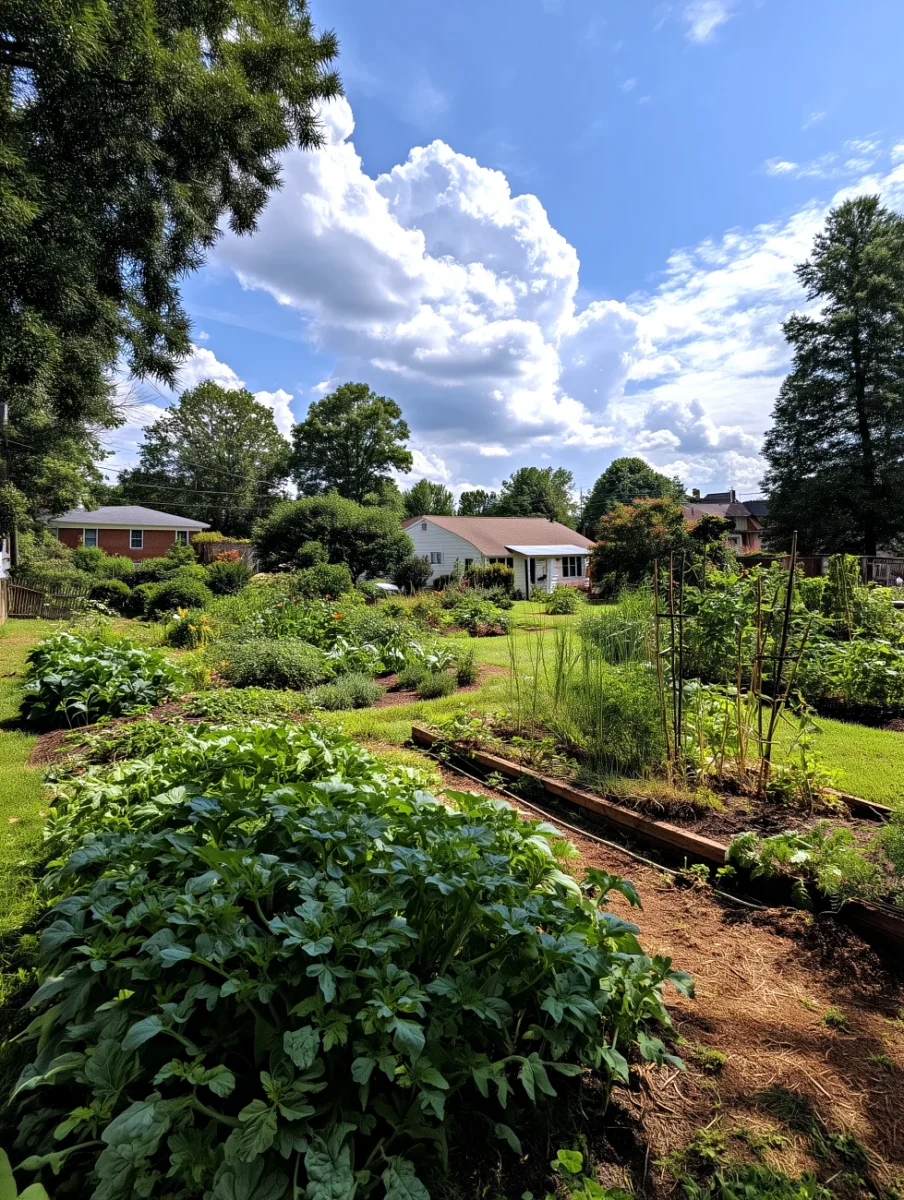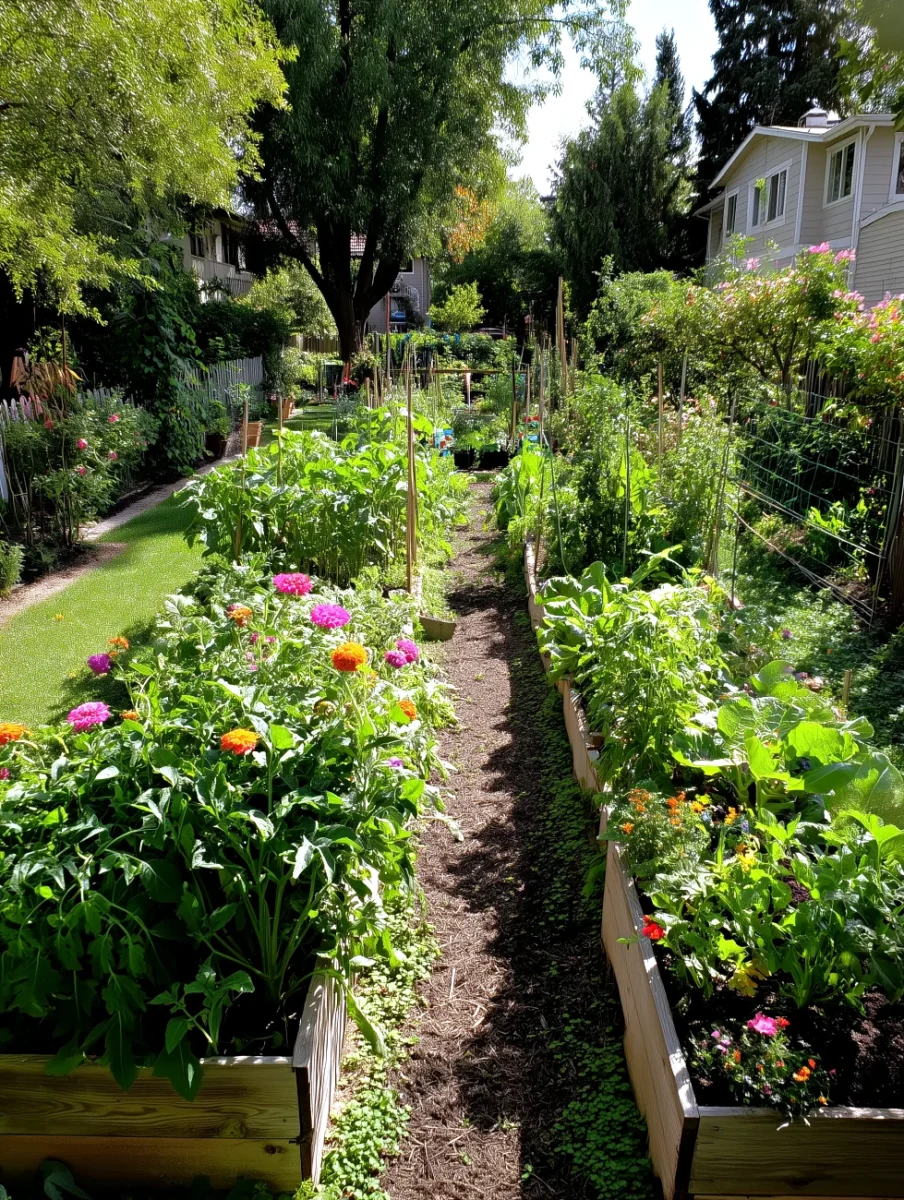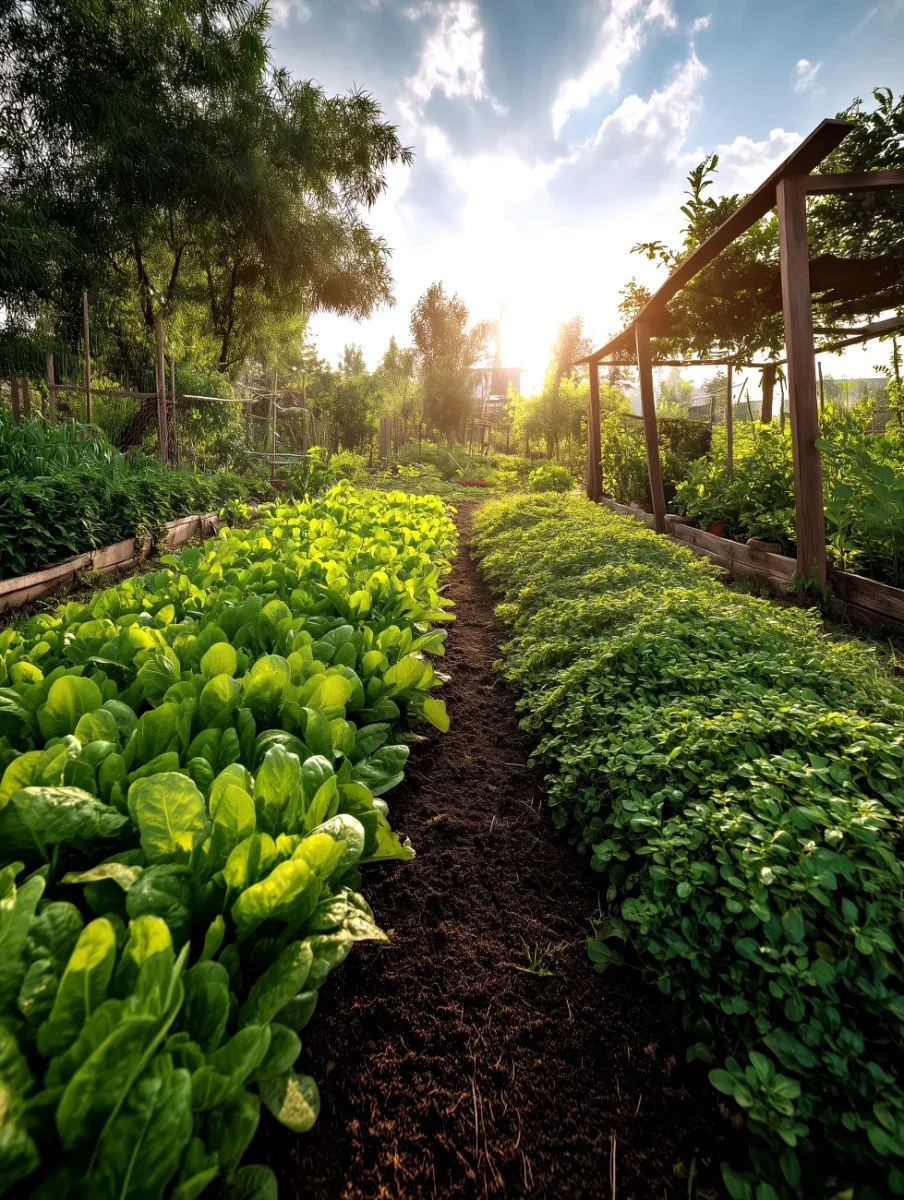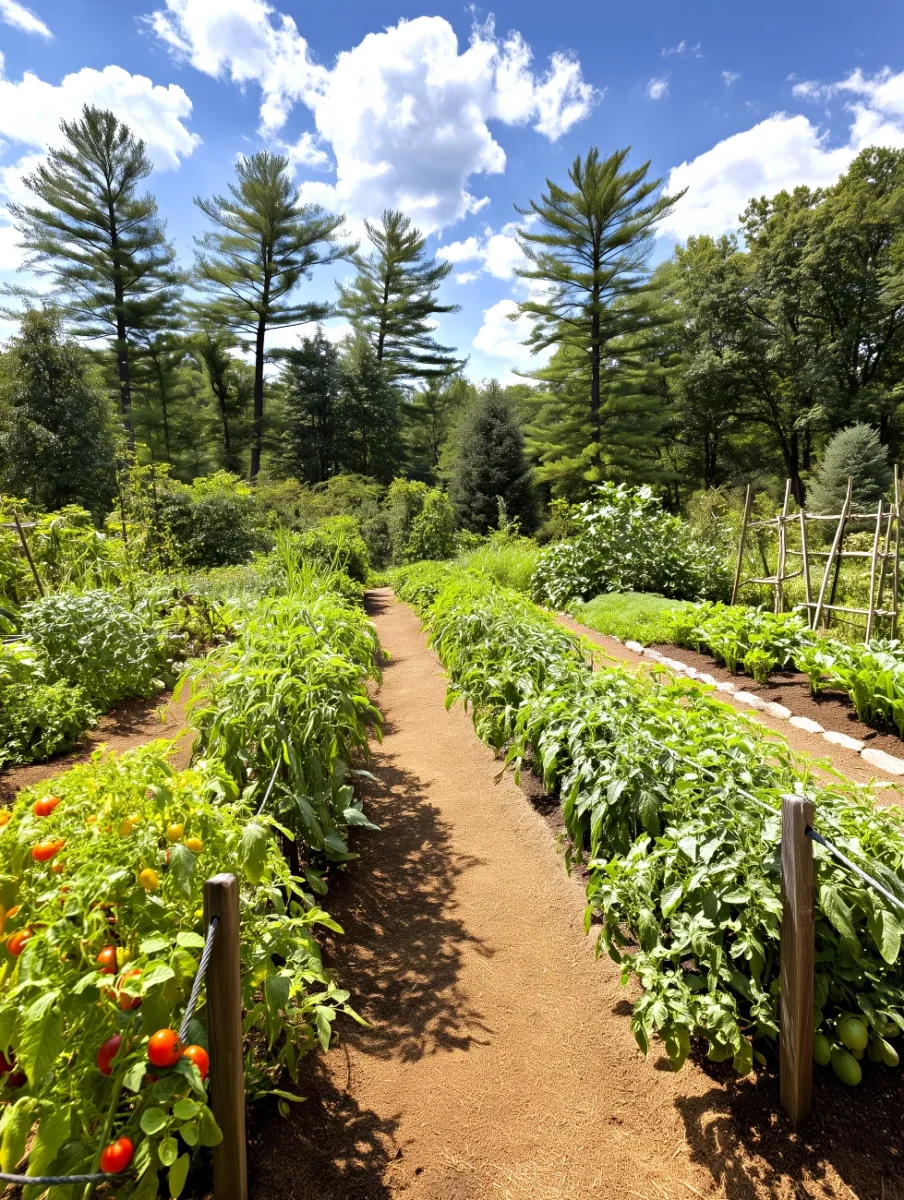
We have created this comprehensive vegetable planting guide for USDA Zones 7-8, especially for guide Zone 7-8 gardeners
These warmer transitional zones, with average annual minimum temperatures ranging from 0°F to 20°F (-17.8°C to -6.7°C), offer an extended growing season that opens up exciting possibilities for gardeners.
With last frost dates typically occurring between mid-March and mid-April and first frost dates between late October and November, gardeners in these zones enjoy approximately 7-8 months of prime growing conditions.
This vegetable planting guide for USDA Hardiness Zones 7-8 is designed to take advantage of the longer growing season in Zones 7-8, which allows for multiple plantings of many crops and even winter harvests of cold-hardy vegetables.
Many gardeners in these zones can plant earlier in spring and later in fall than those in cooler regions, with some areas even supporting year-round growing of certain crops. The recommended varieties and timing are specifically selected to help you maximize productivity in these favorable conditions.
You should read alongside our monthly vegetable gardening calendar for Zones 7-8, which sets out all your sowing, planting and harvesting tasks on a month by month basis.
Use the at-a-glance calendar for quick reference and explore the detailed growing information for specific tips on each vegetable. Happy gardening!
Vegetable Planting Guide for USDA Zones 7-8 At-a-Glance
| Vegetable | Indoor Sowing | Direct Sowing | Transplant | Harvest |
|---|---|---|---|---|
| Aubergine (Eggplant) | Dec-Feb | Not recommended | Mar-Apr | Jul-Oct |
| Broad Beans (Fava) | Jan (optional) | Feb-Mar, Oct-Nov | Mar | May-Jul |
| French/Runner Beans | Mar-Apr | Apr-Jul | Apr-May | Jun-Oct |
| Beetroot (Beets) | Not common | Feb-Apr, Aug-Sep | Mar-Apr | May-Jul, Oct-Nov |
| Broccoli (Calabrese) | Jan-Feb, Jul-Aug | Feb-Mar, Jul-Aug | Feb-Mar, Sep-Oct | May-Jun, Nov-Dec |
| Broccoli – Purple Sprouting | Not common | Aug-Sep | Oct | Jan-Mar (following year) |
| Brussels Sprouts | Mar-Apr, Jun | Not common | May, Aug | Oct-Jan |
| Cabbage – Spring | Not common | Aug-Sep | Oct-Nov | Feb-Apr |
| Cabbage – Summer | Jan-Mar, Aug | Not common | Mar-Apr, Sep | Jun-Aug, Nov-Dec |
| Cabbage – Red/Savoy (Autumn/Winter) | Mar-Apr, Sep | Not common | May, Nov | Oct-Dec, Mar-Apr |
| Carrots | Not recommended | Feb-May, Aug | Not recommended | May-Jul, Oct-Nov |
| Cauliflower – Summer | Jan-Feb | Not common | Mar | May-Jun |
| Cauliflower – Winter (Fall harvest) | Aug | Not common | Sep | Nov-Dec |
| Celeriac | Jan-Feb | Not recommended | Apr | Sep-Nov |
| Celery | Feb-Mar | Not common | Apr-May | Jun-Sep |
| Chard (Swiss Chard) | Not common | Feb-May, Sep | Not common | Apr-Jul, Oct-Dec |
| Courgettes/Marrows (Zucchini) | Mar-Apr | Apr-Jun | Apr-May | Jun-Sep |
| Cucumbers | Feb-Mar | Apr-Jun, Aug | Apr-May | Jun-Sep |
| Garlic | Not applicable | Oct-Nov, Jan | Not applicable | May-Jun |
| Kohl Rabi | Not common | Feb-Apr, Aug | Not common | Apr-Jun, Oct-Nov |
| Melons | Feb-Mar | Not recommended | Apr-May | Jul-Sep |
| Kale | Not common | Feb-Mar, Aug-Sep | Apr, Oct | Apr-Jun, Nov-Feb |
| Lettuce | Not common | Feb-May, Sep-Oct | Not common | Mar-Jun, Oct-Dec |
| Leeks | Jan-Feb | Mar | Apr-May | Aug-Feb |
| Onions | Dec-Jan | Feb | Mar | Jun-Jul |
| Spring Onions (Scallions) | Not common | Feb-May, Aug-Oct | Not common | Apr-Jul, Oct-Dec |
| Parsnips | Not recommended | Feb-Apr | Not recommended | Oct-Feb |
| Peas – 1st Earlies | Jan-Feb | Feb-Mar, Sep | Feb-Mar | Apr-Jun, Nov |
| Peas – 2nd/Maincrop | Not common | Feb-Apr, Aug | Not common | May-Jul, Oct-Nov |
| Peppers (Capsicum & Chilli) | Dec-Feb | Not recommended | Mar-Apr | Jun-Oct |
| Potatoes | Not applicable | Feb-Mar, Aug | Not applicable | May-Sep |
| Pumpkins/Squash | Feb-Apr | Apr-May | Apr-May | Jul-Oct |
| Radish | Not recommended | Feb-May, Sep-Nov | Not recommended | Mar-Jun, Oct-Dec |
| Rocket (Arugula) | Not common | Feb-May, Sep-Nov | Not common | Mar-Jun, Oct-Dec |
| Spinach | Not common | Feb-Apr, Sep-Oct | Not common | Apr-Jun, Nov-Dec |
| Sweet Corn | Feb-Apr | Mar-May, Jul | Apr | Jun-Sep |
| Turnips | Not recommended | Feb-Apr, Aug-Oct | Not recommended | May-Jul, Oct-Dec |
| Swedes (Rutabaga) | Not recommended | Mar-Apr, Aug | Not recommended | Jul-Sep, Dec-Jan |
| Tomatoes | Dec-Feb | Not recommended | Mar-Apr | Jun-Oct |
Detailed Growing Information
Aubergine (Eggplant)
- Sow indoors: Dec-Feb (8 weeks before last frost)
- Transplant: Mar-Apr (after last frost)
- Harvest: Jul-Oct
- Tips: Eggplants are started indoors in winter and planted out in mid-spring when nights stay warm. Harvest begins earlier than in cooler zones, typically by July, and continues into fall until frost.
Broad Beans (Fava)
- Sow indoors: Jan (optional, under cover)
- Direct sow: Feb-Mar (as soon as soil can be worked); Oct-Nov (for overwintering in mild winter areas)
- Transplant: Mar (for any indoor starts)
- Harvest: May-Jul
- Tips: In zones 7-8, sow fava beans as soon as late winter for a spring crop. Fall sowing in October can overwinter and yield in spring if winters are mild. Harvest is generally finished by hot summer weather.
French/Runner Beans
- Sow indoors: Mar-Apr (early starts)
- Direct sow: Apr-Jul (after frost)
- Transplant: Apr-May
- Harvest: Jun-Oct
- Tips: Warm-season beans can be direct-sown earlier (late April) as frosts end sooner. Successive sowings through early summer give harvests from June until fall. In zone 8, a late July sowing can even yield a late fall crop before frost.
Beetroot (Beets)
- Direct sow: Feb-Apr (outdoors); Aug-Sep (for fall crop)
- Transplant: Mar-Apr (if started indoors)
- Harvest: May-Jul; Oct-Nov (for fall sowings)
- Tips: Beets can be sown as soon as the soil is workable in late winter. A second sowing in late summer is ideal for a fall harvest of tender roots.

Broccoli (Calabrese)
- Sow indoors: Jan-Feb; Jul-Aug (for fall crop)
- Direct sow: Feb-Mar; Jul-Aug (for fall crop)
- Transplant: Feb-Mar (spring seedlings); Sep-Oct (fall seedlings)
- Harvest: May-Jun (spring planting); Nov-Dec (fall planting)
- Tips: Zones 7-8 allow two broccoli seasons. Transplant spring-started broccoli by March for early-summer heads. For fall broccoli, sow mid-summer and plant out in early fall; harvest maturing heads in late fall when cool weather arrives.
Broccoli – Purple Sprouting
- Direct sow: Aug-Sep
- Transplant: Oct
- Harvest: Jan-Mar (following year)
- Tips: In mild-winter zones, PSB can be treated like an overwintering crop: sown late summer and transplanted in fall to yield in late winter. Note: In zone 7, severe winters may still hamper PSB; it thrives in zone 8 winters.
Brussels Sprouts
- Sow indoors: Mar-Apr (for fall crop); Jun (for overwintering crop)
- Transplant: May (for spring sowing); Aug (for late sowing)
- Harvest: Oct-Dec, and into Jan (if overwintered)
- Tips: Brussels sprouts are often grown for fall: sow in spring and transplant by early summer for a fall harvest. You can also sow a bit later and overwinter the plants to harvest sprouts in winter, especially in zone 8.
Cabbage – Spring (Spring Greens)
- Direct sow: Aug-Sep
- Transplant: Oct-Nov
- Harvest: Feb-Apr
- Tips: To mimic UK spring cabbage, sow in late summer and overwinter. In zone 7-8, protect from hard freezes; harvest as spring greens in late winter/early spring.
Cabbage – Summer
- Sow indoors: Jan-Mar (for summer harvest); Aug (for fall harvest)
- Transplant: Mar-Apr (spring crop); Sep (fall crop)
- Harvest: Jun-Aug (spring sowing); Nov-Dec (fall sowing)
- Tips: In zones 7-8, you can grow two cabbage crops. Early cabbage is started in winter and heads up in summer. A second sowing in mid-summer, transplanted by early fall, will form heads in late fall.
Cabbage – Red/Savoy (Autumn/Winter)
- Sow indoors: Mar-Apr (for fall harvest); Sep (for spring harvest)
- Transplant: May (for fall); Nov (for spring, if climate permits)
- Harvest: Oct-Dec; Mar-Apr
- Tips: Hardy cabbages can be grown either spring-planted for autumn harvest, or fall-planted to overwinter. In zone 7, fall-planting is preferable for a spring harvest.
Carrots
- Direct sow: Feb-May; Aug (for fall crop)
- Harvest: May-Jul (spring sowings); Oct-Nov (fall sowing)
- Tips: Begin direct-sowing carrots as early as late winter (Feb) for late-spring carrots. Another sowing in late summer (August) will mature in the cooler fall months. Carrots can even overwinter in-ground in zone 8 for early spring harvest.
Cauliflower – Summer
- Sow indoors: Jan-Feb
- Transplant: Mar
- Harvest: May-Jun
- Tips: An early cauliflower crop can be started in winter and harvested in late spring before intense heat, since cauliflower prefers cool conditions.
Cauliflower – Winter (Fall harvest)
- Sow indoors: Aug
- Transplant: Sep
- Harvest: Nov-Dec
- Tips: For zones 7-8, fall cauliflower is often more reliable than spring. Sow in later summer and harvest heads in the fall when cool weather returns.
Celeriac
- Sow indoors: Jan-Feb
- Transplant: Apr
- Harvest: Sep-Nov
- Tips: Requires a long season; start very early indoors (January) and harvest roots in the fall.
Celery
- Sow indoors: Feb-Mar
- Transplant: Apr-May
- Harvest: Jun-Sep
- Tips: Start indoors in late winter; transplant after last frost. In zone 8, a late summer sowing is also possible for a fall crop if kept watered.
Chard (Swiss Chard)
- Direct sow: Feb-May; Sep (for fall/winter crop)
- Harvest: Apr-Jul; Oct-Dec
- Tips: Swiss chard is hardy and can be sown in late winter for spring use. It endures heat better than spinach, and fall sowings in zone 8 can provide winter greens.
Courgettes/Marrows (Zucchini)
- Sow indoors: Mar-Apr
- Direct sow: Apr-Jun
- Transplant: Apr-May
- Harvest: Jun-Sep
- Tips: Sow or transplant one month earlier than cooler zones: often started in March and planted out by late April in zone 8. First zucchini can be picked by June and production continues into fall until frost.
Cucumbers
- Sow indoors: Feb-Mar
- Direct sow: Apr-Jun; Aug (for second crop)
- Transplant: Apr-May
- Harvest: Jun-Sep
- Tips: In zone 8, cucumbers can be planted by late April and will bear from early summer through early fall. A late summer sowing (Aug) is also possible for a second crop, with harvest before frost.
Garlic
- Direct sow: Oct-Nov (fall planting of cloves); Jan (if fall planting missed)
- Harvest: May-Jun
- Tips: In zones 7-8, fall planting is still best (garlic needs cold period) – plant in October and harvest in late spring, which is earlier than cooler zones. Softneck varieties also do well with fall planting.
Kohl Rabi
- Direct sow: Feb-Apr; Aug (for fall crop)
- Harvest: Apr-Jun; Oct-Nov
- Tips: Kohlrabi likes cool weather – start early spring for late spring harvest, and again in late summer for autumn harvest.
Melons
- Sow indoors: Feb-Mar
- Transplant: Apr-May
- Harvest: Jul-Sep
- Tips: In warm zones, melons can be started by late winter indoors and transplanted by mid-spring. Long, hot summers yield melons from mid-summer into early fall.
Kale
- Direct sow: Feb-Mar (for spring); Aug-Sep (for fall/winter)
- Transplant: Apr (spring); Oct (fall)
- Harvest: Apr-Jun; Nov-Feb
- Tips: Kale can be almost year-round. Spring-sown kale provides greens in late spring/early summer. More often, gardeners sow in late summer for a fall and winter crop; kale in zones 7-8 can survive winter and be harvested into the next spring.
Lettuce
- Direct sow: Feb-May; Sep-Oct (for fall/winter crop)
- Harvest: Mar-Jun; Oct-Dec
- Tips: In mild-winter zones, lettuce is a prime fall and even winter crop. Sow in early spring for late spring harvest, and sow again in early fall for abundant autumn salads. In mild winters, continuous winter sowings are possible.
Leeks
- Sow indoors: Jan-Feb
- Direct sow: Mar
- Transplant: Apr-May
- Harvest: Aug-Dec (and overwintered into Feb)
- Tips: Start leeks indoors by mid-winter and transplant in spring for a long growing season. Many zone 7/8 gardeners also sow in late summer to overwinter small leeks and harvest in spring.
Onions
- Sow indoors: Dec-Jan
- Direct sow: Feb (sets or seeds)
- Transplant: Mar
- Harvest: Jun-Jul
- Tips: In zones 7-8, it’s common to start bulbing onions in winter or plant onion sets in very early spring. They mature by mid-summer. Short-day onion varieties may be planted in fall in zone 8 for late spring harvest.
Spring Onions (Scallions)
- Direct sow: Feb-May; Aug-Oct
- Harvest: Apr-Jul; Oct-Dec
- Tips: Scallions can be succession-sown in both spring and late summer/fall in zones 7-8. Avoid the hottest mid-summer period and deep winter freezes, but otherwise they are very flexible.
Parsnips
- Direct sow: Feb-Apr
- Harvest: Oct-Feb
- Tips: Sow as soon as ground is workable in late winter. Parsnips will mature by autumn and taste sweetest after frost – they can be left in the ground over winter in zones 7-8.
Peas – 1st Earlies
- Sow indoors: Jan-Feb (protected)
- Direct sow: Feb-Mar; Sep (for fall crop)
- Transplant: Feb-Mar
- Harvest: Apr-Jun (spring sowings); Nov (fall sowing)
- Tips: In zone 7+, peas can be planted very early – even in late January under protection – for spring harvest. Additionally, a late August/early September sowing of fast-maturing peas can yield a late fall crop before frost in zone 8.
Peas – 2nd/Maincrop
- Direct sow: Feb-Apr (for summer); Aug (for fall)
- Harvest: May-Jul; Oct-Nov
- Tips: Maincrop peas in spring are sown into April for summer harvest. Many varieties also do well in fall: sow in later summer and pick pods in autumn until freezing weather.

Peppers (Capsicum & Chilli)
- Sow indoors: Dec-Feb
- Transplant: Mar-Apr
- Harvest: Jun-Oct
- Tips: Start peppers very early indoors (December/January for zone 8, by Feb for zone 7) as they need a long season. Set plants out in spring (April or earlier in zone 8). With the long hot summers, peppers produce from early summer well into fall.
Potatoes
- Plant: Feb-Mar (earlier for zone 8); Aug (for fall crop)
- Harvest: May-Jul (earlies); Jul-Sep (maincrop)
- Tips: Plant seed potatoes about 2-4 weeks earlier than in cooler zones – often by February in zone 8. Earliest new potatoes can be dug in late spring. Maincrop varieties planted in March are harvested by late summer. In zone 8, a fall potato planting in August is also possible for winter harvest.
Pumpkins/Squash
- Sow indoors: Feb-Apr
- Direct sow: Apr-May
- Transplant: Apr-May
- Harvest: Jul-Oct
- Tips: With the longer season, squash and pumpkin seeds can be started by late winter indoors and transplanted by April. They will flower and set fruit earlier, yielding from mid-summer onward. Pumpkins for Halloween are typically harvested by October.
Radish
- Direct sow: Feb-May; Sep-Nov
- Harvest: Mar-Jun; Oct-Dec
- Tips: Radishes can’t germinate in extreme heat, but in zone 8 you can sow in fall and even winter. Plant heavily from late winter to late spring, then again in the cooler fall. Spring sowings mature in 4-6 weeks; fall sowings can be harvested through winter in mild areas.
Rocket (Arugula)
- Direct sow: Feb-May; Sep-Nov
- Harvest: Mar-Jun; Oct-Dec
- Tips: Arugula loves cool weather. Zones 7-8 allow early spring sowings and fall sowings. It will bolt in hot summer, so avoid June-July planting. Fall crops thrive and can even survive light frosts, providing greens into winter.
Spinach
- Direct sow: Feb-Apr; Sep-Oct
- Harvest: Apr-Jun; Nov-Dec
- Tips: Like other leafy greens, spinach is a cool-season crop that can be grown in spring and fall. In zone 8, sow in February for spring greens, and again in early fall for a late fall to early winter harvest. Summer heat causes quick bolting, so it’s not grown in mid-summer.
Sweet Corn
- Sow indoors: Feb-Apr
- Direct sow: Mar-May; Jul (for fall crop in zone 8)
- Transplant: Apr (if started early)
- Harvest: Jun-Sep
- Tips: Corn can be planted much earlier in warmer zones – often direct-sown by April 1 in zone 8. Early indoor sow (Feb) can yield super-early corn by June. Successive sowings until May give harvests all summer. In zone 8, a July planting can provide fall corn.

Turnips
- Direct sow: Feb-Apr; Aug-Oct
- Harvest: May-Jul; Oct-Dec
- Tips: Turnips grow fast and prefer cool conditions. Sow in late winter for late-spring roots, and again in late summer or early fall for autumn use. In zone 8, turnips sown in October can even be pulled in December.
Swedes (Rutabaga)
- Direct sow: Mar-Apr; Aug (for winter crop)
- Harvest: Jul-Sep; Dec-Jan
- Tips: Rutabaga can be spring-sown for late summer harvest or sown in August for winter use. In zones 7-8, fall-grown swedes are common – they size up in cool autumn weather and can be left in ground until mid-winter.
Tomatoes
- Sow indoors: Dec-Feb
- Transplant: Mar-Apr (after last frost)
- Harvest: Jun-Oct
- Tips: Tomatoes are started extremely early indoors in zones 7-8 – often January or February – to get a head start. Transplant out by March/April (earlier in zone 8, later in zone 7). Expect the first ripe tomatoes by June. With frost arriving late (Nov+), indeterminate tomatoes can continue producing into October. Some growers plant a second crop in mid-summer for fall production in zone 8.
Vegetable Gardening Guide Resources
Martin Cole has been an avid plant lover and gardener for more than 20 years and loves to talk and write about gardening. In 2006 he was a finalist in the BBC Gardener of the Year competition. He is a member of the National dahlia Society.
He previously lived in London and Sydney, Australia, where he took a diploma course in Horticultural studies and is now based in North Berwick in Scotland. He founded GardeningStepbyStep.com in 2012. The website is aimed at everybody who loves plants or has been bitten by the gardening bug and wants to know more.
Gardening Step by Step has been cited by Thompson and Morgan, the UK’s largest mail order plant retailer, as a website that publishes expert gardening content.

